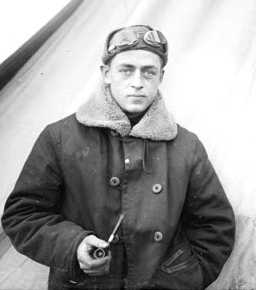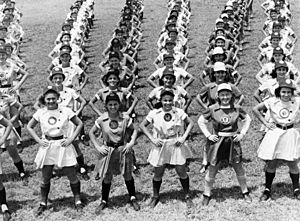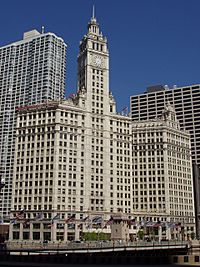Philip K. Wrigley facts for kids
Quick facts for kids
Philip K. Wrigley
|
|
|---|---|

Wrigley in 1917
|
|
| Born | December 5, 1894 |
| Died | April 12, 1977 (aged 82) |
| Nationality | American |
| Education | Phillips Academy University of Chicago |
| Occupation | Chewing gum manufacturer and executive in Major League Baseball |
| Children | William Wrigley III Ada Wrigley Schreiner |
| Parent(s) | William Wrigley Jr. Ada Foote Wrigley |
Philip Knight Wrigley (December 5, 1894 – April 12, 1977), often called P. K. Wrigley, was an American businessman. He was famous for making chewing gum and for being a leader in Major League Baseball. He took over these important roles from his father, William Wrigley Jr.. Philip was known as the quieter son compared to his more outgoing dad.
Contents
Philip K. Wrigley's Life
Philip Wrigley was born in Chicago in 1894. He went to Phillips Academy in Andover, Massachusetts, and finished there in 1914. He also briefly studied at the University of Chicago.
When his father, William Wrigley Jr., passed away in 1932, Philip took on a bigger role in the family's businesses. He became the head of the Wm. Wrigley Jr. Company, which made chewing gum. He also took charge of the family's favorite hobby, the Chicago Cubs baseball team. He owned the Cubs until he died. In 1961, he gave the job of president of the gum company to his son, William Wrigley III, but he stayed as the president of the Cubs.
The Chicago Cubs and New Ideas
While the chewing gum business did very well, the Cubs baseball team struggled over the years. After playing in the 1945 World Series, they only had seven winning seasons in the next 32 years. This included a long period from 1947 to 1962 where they didn't have a single winning season. They did have a short time of success in the late 1960s and early 1970s, but they never won a championship.
Philip Wrigley was very creative in some ways. For example, he didn't want to install lights at Wrigley Field during World War II. Instead, he donated the light poles to the military to help with the war effort.
In 1961, he tried a new idea for the Cubs. He got rid of the traditional manager and coaches system. Instead, he created a "College of Coaches". This was a bit like how coaches specialize today. However, his big mistake was not having one main manager. He had different coaches take turns being the "head coach." Without strong and steady leadership, the Cubs continued to lose games. This happened even though they had amazing players like Ernie Banks, Ron Santo, and Billy Williams on the team. After a lot of jokes and criticism from the media and players, Wrigley stopped the "College of Coaches" idea. In 1966, he hired Leo Durocher to be the Cubs' manager.
All-American Girls Professional Baseball League

During World War II, many male baseball players were drafted into the military. This meant that Major League Baseball teams were losing their best players. To keep people interested in baseball, Philip Wrigley started the All-American Girls Professional Baseball League (AAGPBL). This league featured women playing professional baseball.
The story of the AAGPBL was later made into a famous movie in 1992 called A League of Their Own. In the movie, the character of Walter Harvey, who owns a candy bar company, is loosely based on Philip Wrigley.
Media and Advertising
Just like his father, Philip Wrigley believed it was important to get as much media attention as possible. He hired Otis Shepard and Dorothy Shepard to help him with advertising.
Starting in the 1920s, Cubs games were broadcast a lot on the radio. Sometimes, different radio stations would even broadcast the same game at the same time for very low fees. After World War II, when baseball was very popular, Wrigley continued this practice. He allowed WGN-TV to show all the Cubs' home games and many of their away games too.
Some other team owners were surprised that Wrigley seemed to be "giving away" his product for free. But this decision paid off greatly in the long run. As WGN-TV became a "superstation" (a TV station broadcast across the whole country), it created a huge fan base for the Cubs all over the United States. This meant that "Beautiful Wrigley Field" was almost always full of fans, no matter how well the team was playing.

When he was younger, Philip Wrigley was often seen with the Cubs. But in his later years as owner, he rarely went to games. He usually shared his thoughts through memos or even full-page newspaper ads.
There's a funny story about a Cubs player named Pete LaCock. He was known for his sense of humor. Once, he went to the Wrigley Building and asked to meet Philip Wrigley. Wrigley asked LaCock what he wanted, and LaCock replied, "Nothing. I just wanted to see if you really exist!"
Protecting Nature
Philip Wrigley continued his father's work in protecting the environment. In 1972, he created the Catalina Island Conservancy. He then donated most of Santa Catalina Island to this group. This island is about 26 miles (42 km) off the coast of Los Angeles.
Later Years and Legacy
Philip Wrigley passed away on April 12, 1977, due to a stomach problem. He became ill at his home in Lake Geneva, Wisconsin, and died at a hospital in Elkhorn, Wisconsin.
After Philip Wrigley died, his son, William III, became the president of the Cubs. Just a few months later, Philip's wife (William III's mother) also passed away. This meant William III had to pay a lot of money in estate taxes. Because of these taxes, William III had to sell the Cubs to the Tribune Company in 1981. This ended more than 60 years of the Wrigley family being involved with the team. However, the ballpark is still called Wrigley Field today.

